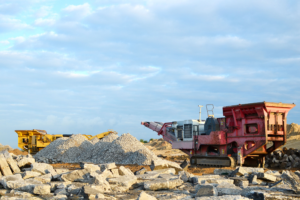China Stimulus Hope Fades: What It Means for ASX Iron Ore Giants

The Australian mining sector, particularly the iron ore giants, is undergoing a period of uncertainty, marked by the fading hopes around China’s stimulus efforts. As the world’s second-largest economy struggles to revive key sectors, particularly the property and steel industries, the implications for Australian miners, especially BHP (ASX: BHP), Rio Tinto (ASX: RIO), and Fortescue Metals Group (ASX: FMG), are substantial. The price of iron ore, which has historically been a significant revenue stream for these companies, has taken a sharp hit due to China’s struggling recovery efforts. As these stimulus measures deflate, what does this mean for the ASX’s mining stocks, and more importantly, for investors?
What are the Best ASX stocks to invest in right now?
Check our buy/sell tips
Hook: China’s Stimulus Promises Not Delivering for Aussie Miners
For months, there was optimism in the global markets surrounding China’s stimulus efforts, particularly the impact these measures would have on commodities like iron ore. Many analysts had anticipated a surge in demand for iron ore as China moved to boost its economic activity, especially in its construction and steel sectors, by rolling out large-scale stimulus packages. These efforts were expected to rejuvenate the property market, which in turn would lift the steel demand, and thus iron ore.
However, despite several rounds of government support, China’s stimulus efforts have failed to deliver the expected results. While some support packages were rolled out to stimulate the economy, they were largely underwhelming and insufficient to spark the demand needed to revive China’s struggling property market. The ripple effects of this are being acutely felt by Australia’s iron ore giants, whose fortunes are closely tied to Chinese demand.
In early October 2025, reports from The Guardian and Reuters indicated that China’s state-backed buyer, China Mineral Resources Group, instructed some steel mills to pause new purchases of BHP iron ore cargoes amid pricing disputes. This move underscores rising trade tension and adds further uncertainty for Australian exporters. As the hopes surrounding these stimulus packages fade, the outlook for the iron ore market and the ASX mining stocks becomes less optimistic.
Industry Focus: Property Market Weakness and Steel Demand Dynamics
China’s property market has long been a key driver of its economic growth, with demand for steel, a primary ingredient in construction, directly influencing the demand for iron ore. Unfortunately, the sector is now facing considerable headwinds. For several years, China’s property market has been plagued by high levels of debt, reducing the ability of developers to fund new projects and maintain construction levels. The central government’s stimulus measures, aimed at addressing these issues, have thus far been largely ineffective. Even with government intervention, the property market continues to show signs of severe weakness, leading to modest declines in steel output rather than a complete slowdown.
As steel demand wanes, the knock-on effect is felt by iron ore suppliers, including Australian miners, who have historically relied on China as their primary consumer of iron ore. The struggle to restart China’s construction boom has caused slower production growth and weaker order volumes, leaving iron ore prices under pressure. According to Bank of America (BoA), iron ore prices could fall below the US$80 per tonne mark if China’s economic headwinds persist, a scenario reminiscent of the commodity’s COVID-era lows.
Iron Ore Price Forecasts: BoA Warning Sub-$80
The iron ore price has been on a downward trajectory for several months, with significant concern over China’s ongoing struggle to stimulate demand. Bank of America analysts have warned that iron ore prices could dip below US$80 per tonne if Chinese demand continues to weaken, a conditional forecast rather than an immediate reality. While the long-term outlook for iron ore remains uncertain, particularly as China rebalances its economy, the short-term prospects are far more concerning.
For ASX-listed mining companies, this presents a difficult environment. The price of iron ore plays a central role in the profitability of these companies, and a sustained drop can significantly reduce their export earnings. In turn, investors have grown more cautious, with many reassessing their positions in BHP, Rio Tinto, and Fortescue Metals Group. As China’s economic recovery stalls and the promise of stimulus fades, it is clear that the iron ore market is heading into choppy waters in the short term, with lower prices expected to persist.
Stock Analysis
BHP (ASX: BHP): Navigating a Slowing Market
BHP (ASX: BHP), one of the largest global iron ore producers, has seen its share price fluctuate around the $42–$45 range in recent months as sentiment over China’s stimulus has weakened. Despite BHP’s efforts to diversify its portfolio into other commodities like copper, oil, and potash, the company remains heavily reliant on iron ore exports to China. Given that China is the world’s largest importer of iron ore, any downturn in demand for steel and construction will have an outsized impact on BHP’s bottom line.
The challenges facing BHP are compounded by increasing operational costs, as the company faces rising expenses for production and transportation. While BHP remains a giant in the mining sector, its heavy reliance on iron ore exports to China, combined with weaker-than-expected demand from the property and steel sectors, has raised concerns over its future profitability in the short term.
Rio Tinto (ASX: RIO): A Rising Tide?
Rio Tinto (ASX: RIO), another major player in the global iron ore market, has seen similar challenges. With iron ore representing a significant portion of the company’s revenue, Rio’s fortunes are closely tied to the performance of the commodity. Although the company has made significant strides in diversifying its portfolio, including investments in lithium and copper, iron ore remains its most important revenue generator.
Like BHP, Rio Tinto is feeling the pinch of declining iron ore prices as the Chinese stimulus falters. However, Rio has been actively working to mitigate this risk by expanding its exposure to battery materials such as lithium, which has seen a surge in demand due to the growing electric vehicle (EV) market. Still, the company’s dependency on iron ore exports to China leaves it vulnerable in the face of ongoing weakness in China’s property and construction sectors.
Fortescue Metals Group (ASX: FMG): Facing Rising Costs
Fortescue Metals Group (ASX: FMG), Australia’s third-largest iron ore producer, is another company heavily impacted by the falling price of iron ore. Fortescue operates with a slightly higher cost base than BHP and Rio Tinto, which can pressure its margins when iron ore prices fall. While FMG has made significant strides in diversifying into renewable energy and copper, iron ore remains the company’s most profitable sector.
As the price of iron ore drops, FMG will likely see its margins squeezed, making it more difficult to sustain profitability. The company’s exposure to iron ore remains a critical risk, particularly in the face of ongoing Chinese economic struggles and reduced demand for steel. To mitigate these risks, FMG will need to continue focusing on diversifying its revenue streams while managing its iron ore cost structure.
Mineral Resources (ASX: MIN): Exposure to Market Volatility
Mineral Resources (ASX: MIN), while not as large as BHP, Rio Tinto, or FMG, is another significant player in Australia’s iron ore sector. The company has faced similar challenges with falling iron ore prices, but its diversified portfolio, which includes lithium and other battery minerals, gives it a partial hedge against the downturn in iron ore.
Mineral Resources’ strong presence in the lithium market could help it weather the storm in the iron ore sector, but its iron ore exposure still represents a notable risk. As the Chinese property market continues to struggle, the company will need to balance its iron ore business with its expanding battery-materials operations to reduce reliance on volatile iron ore prices.
Conclusion
The fading hope around China’s stimulus measures is continuing to weigh on market sentiment toward Australian iron ore producers. With iron ore prices under pressure, major miners like BHP, Rio Tinto, and Fortescue Metals Group are navigating a challenging environment. While near-term demand may stay subdued, long-term iron ore consumption will depend on global infrastructure investment and industrial growth in emerging markets.
For investors, this period represents both risk and opportunity. The key will be staying informed on China’s economic trajectory and understanding how these iron ore giants are positioning themselves amid the current downturn. While short-term prospects may be uncertain, long-term investors may still find opportunities in these companies as they diversify their operations and adapt to shifting global demand.
FAQs
- How has China’s stimulus failure impacted iron ore prices?
China’s stimulus measures were expected to boost steel demand and, by extension, iron ore. However, the underwhelming results from these packages, particularly in the property sector, have led to reduced demand, keeping iron ore prices under pressure near the US$100 mark.
- What is the outlook for ASX-listed iron ore companies?
The outlook for ASX iron ore giants like BHP, Rio Tinto, and Fortescue Metals Group is uncertain in the short term. With iron ore prices easing and China’s recovery sluggish, these companies face earnings pressure. Long-term performance will depend on diversification and global demand trends.
- How low can iron ore prices go?
According to analysts, including Bank of America, iron ore prices could dip below US$80 per tonne if China’s economic challenges persist. This represents a significant risk for Australian miners reliant on iron ore exports.
- Are there any other factors affecting iron ore prices aside from China’s stimulus?
Yes, factors include global steel demand, freight costs, supply expansions in Brazil and Australia, and macroeconomic conditions in key markets like Europe and the US. The ongoing post-pandemic recovery also influences commodity trade flows.
- Which ASX stocks are most exposed to iron ore price fluctuations?
BHP, Rio Tinto, and Fortescue Metals Group remain the most exposed to iron ore price swings, given their dependence on exports to China. Mineral Resources also faces exposure but is somewhat shielded by its lithium business.
Blog Categories
Get Our Top 5 ASX Stocks for FY26
Recent Posts
Develop Global Wins $200m OceanaGold Contract- What It Means for Investors
Develop Global (ASX: DVP) climbed 4% to A$4.36 on Friday after securing a A$200 million underground development contract with global…
Nova Minerals Drops 14% on $20m Capital Raise- Buy or Avoid?
Nova Minerals (ASX: NVA) dropped nearly 14 per cent to A$0.90 following the announcement of a US$20 million (approximately AUD…
WiseTech (ASX:WTC) Rises After Richard White Cleared of Misconduct – Should You Buy the Dip?
WiseTech Global (ASX: WTC) climbed 3 per cent to A$70.18 on Friday after founder and Executive Chairman Richard White was…



